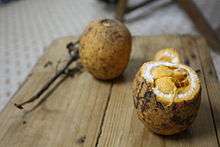Saba senegalensis
Saba senegalensis known as weda in the Moore, French, and English languages, is a fruit producing plant of the Apocynaceae[1] family, native to the Sahel region of sub-Saharan Africa. It has several common names in various West African Languages. The tree grows predominantly on riverbanks and in woodlands in Burkina Faso, Senegal, Mali and Ivory Coast.[2] It has been observed growing as vine up trees, as a small erect shrub, and oftentimes growing to the size of a large tree.
| Saba senegalensis | |
|---|---|
 | |
| Scientific classification | |
| Kingdom: | Plantae |
| Clade: | Tracheophytes |
| Clade: | Angiosperms |
| Clade: | Eudicots |
| Clade: | Asterids |
| Order: | Gentianales |
| Family: | Apocynaceae |
| Genus: | Saba |
| Species: | S. senegalensis |
| Binomial name | |
| Saba senegalensis (A.DC.) Pichon | |
ICRISAT has cited S. senegalensis as a useful food crop plant and as a tool to combat soil degradation in rural Africa.[3]
Fruit
The fruit of Saba senegalensis has a hard yellow peel. The fruit is filled with seed pods that can be sucked on, similar to the consumption of tamarind. It is described as having a tart and sour flavor like that of a mango or lemon.
Drink
Natives of the Sahel region often use the fruit to make a juice.
Propagation
Saba senegalensis is most easily propagated through seeds. Once you acquire seeds, soak them in warm water for 24 hours. Then, start seeds directly in cactus soil mix. Do not overwater. The seeds should sprout within 2–4 weeks. Alternatively, if you have access to a live plant, it can by propagated by use of cuttings. Simply cut a 6-12 inch branch from the plant, and start directly in soil. The plant should fruit within 2–5 years of being planted.
Growing
Saba senegalensis will grow best outdoors in USDA zones 10 and warmer. If you live in a colder zone, you may have success growing it in a pot and bringing it indoors for winter.
Common names

- In the Moore language: "Weda"
- In the Wolof language: "Madd"
- In Gambian Wolof: "Kabaa"
- In the Bambara language: "Zaban"
- In the French language: "Liane saba"
- In Côte d'Ivoire: "saba"
- In Sierra Leone Krio: "Malombo"
- In the Congo basin: "Malombo" or "Makalakonki"
- In Casamance, Senegal. Joola language: "Kuguissai"
References
- "Plants Profile for Saba senegalensis (Senegal saba)". Plants.usda.gov. Retrieved 2013-10-15.
- Burkill, HM. "A tree species reference and selection guide". PROSEA. Retrieved 15 May 2013.
- "Transforming Agriculture in the Sahel Through Tree-Crop-Livestock Systems" (PDF). Icrisat.org. Retrieved 2013-10-15.